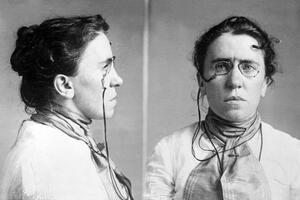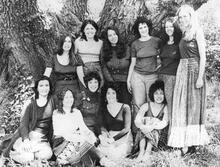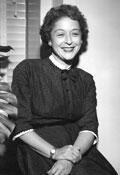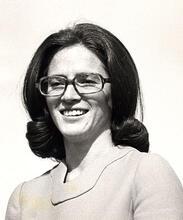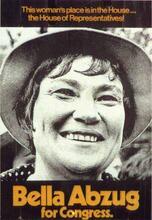Birth Control Movement in the United States: 1912-1960
In the 1910s, Margaret Sanger began the family planning movement in the United States. While Sanger was not Jewish, Jews had an enormous impact on her activism, and her activism indelibly shaped the lives of Jewish women in America. Sanger opened the country’s first birth control clinic in 1916. In 1921, she founded the American Birth Control League, which subsequently became the Planned Parenthood Federation of America. In 1923, she established the Birth Control Clinical Research Bureau. Sanger hired many Jewish women doctors and social workers who could not secure professional placements elsewhere. During the 1950s, she partnered with an American Jew to produce the birth control pill. The following decade, a Jewish gynecologist became president of Planned Parenthood Federation of America.
Margaret Sanger and Contraception in the United States
The dedicated commitment of great numbers of American Jewish women to their country’s long and controversial crusade to legalize birth control had its origins in 1912, when the movement’s formidable pioneer Margaret Sanger—baptized a Catholic, and married to a Jew, but by then calling herself a socialist—was working part-time as a visiting nurse in the immigrant districts of New York City’s Lower East Side. What she came to identify as an “awakening” occurred in the service of a young Jewish woman named Sadie Sachs, whom Sanger assisted through the complications of a self-induced septic abortion. Countless times through her fifty-year career as a reformer, she would repeat the saga of Sachs’s broken plea for reliable contraception and the doctor’s callous rejoinder that she told her husband “to sleep on the roof.” Returning several months later to find Sachs dying of septicemia, Sanger resolved to pursue fundamental social change.
Barrier and chemical contraception—including condoms, cervical caps, womb veils, and douches—had circulated widely in America in the nineteenth century, precipitating a dramatic decline in fertility. This development, in turn, fueled a national preoccupation with moral and social purity. During the 1870s, the federal government and almost every state adopted far-reaching obscenity statutes that criminalized contraception and abortion and prohibited the distribution of information or products intended to promote their use.
Named after their principal architect and chief enforcer, Anthony Comstock, these laws did not succeed in suppressing the traffic in contraception, but they did push it underground, out of the jurisdiction of government bodies that might have regulated price and quality. Consequently, physicians, looking to consolidate their scientific authority, defamed once-common practices. Middle-class fertility continued to decline as the result of private arrangements, but the poor—especially the growing numbers of immigrant poor—were disadvantaged because they often could neither afford contraception nor understand the many popular subterfuges through which it was sold.
Origins of the Movement
Margaret Sanger first drew support from labor organizers and other leftists. “No Gods, No Masters,” the rallying cry of the International Workers of the World, became her personal and political manifesto. Even as the two women jousted for celebrity and quarreled over personal differences, Sanger, inspired by Emma Goldman’s forceful doctrines, published The Woman Rebel (1914), a radical journal that encouraged personal autonomy for women through the use of “birth control,” a phrase she invented to give them an easy way of talking about a delicate subject in public.
Spurred on to renewed militancy by the tragic death of her young daughter from pneumonia, Sanger opened the country’s first birth control clinic in 1916 behind the curtained windows of a tenement storefront in the Brownsville district of Brooklyn. Handbills advertised the location in English, Yiddish, and Italian. Led by the determined Rose Halpern, the mothers of Brownsville quickly rose to Sanger’s defense when the facility was closed down in its second week of operation.
Following a high-profile trial, Sanger’s sister Ethel Byrne, a nurse at Mount Sinai Hospital in New York, was sentenced to one month’s imprisonment in the workhouse on Blackwell Island (now Roosevelt Island), where she made headlines and secured her release through a hunger strike modeled on the attention-getting exploits of the British suffragists. Fania Mindell, a Jewish social worker, was fined fifty dollars for handing out illegal information. Charged with the more serious crime of actually fitting as a birth control device a Mizpah Pessary, which was then commonly sold in pharmacies as a womb support, Sanger was handed and served a full month’s jail term.
Attorney Jonah Goldstein’s appeal of her conviction, however, did establish a medical exception to the New York State birth control prohibitions. Doctors (though not nurses, as Sanger had hoped) were granted the right to prescribe contraception for health reasons, a development that determined the future course of the movement. Free-standing clinics became the model for the distribution of contraception, despite the continued reluctance of the country’s medical establishment to support them. The American Medical Association did not officially endorse birth control until 1937, well after these facilities had demonstrated the efficacy of the rubber-spring diaphragm and spermicidal jelly regimen that Sanger first smuggled to the United States from Europe.
The victory for woman suffrage had been achieved through the efforts of women oriented to activism and looking for a new cause. Birth control, Sanger argued, would enhance the opportunities of women beyond the promises of economic reformers on the one hand and of suffragists on the other. It would be a tool for the fundamental redistribution of power. Women would achieve personal freedom by experiencing their sexuality free of consequence, just as men have always done. But in taking control of the forces of reproduction, they would also lower birthrates, alter the balance of supply and demand for labor, and therein accomplish the revolutionary goals of workers without the social upheaval of class warfare. Bonds of gender would transcend divisions of ethnicity, race, or class. The refusal of women to bear children indiscriminately would alter the course of history.
Achievements in the Movement
In 1921, Sanger founded the American Birth Control League, which subsequently became the Planned Parenthood Federation of America. Still, no matter how much she toned herself down, she remained a target of repression. A lecture at New York City’s Town Hall was closed down by police ostensibly acting on orders of political authorities under pressure from powerful Catholic church officials. Subsequent appearances in Albany, Syracuse, and Boston were canceled or interrupted. These incidents sustained her image as a daring, romantic figure and earned her the moral and political support of progressive leaders of New York’s Protestant and Jewish communities, including Rabbi Stephen Meyer Wise, a leader of the Jewish Reform Movement, and Samuel Rosenman, a young Jewish assemblyman from New York City, who would subsequently serve as a principal adviser to President Franklin Delano Roosevelt.
Reform doctrine in the Protestant and Jewish faiths allowed for relativism in matters of sexuality and for reasonable differences of individual conscience in family size. The rabbis had long ago encouraged sentiment in marriage and recognized the virtues of sexual expression in promoting human happiness. Within one generation, average Jewish family size declined to national norms and subsequently fell below them. By contrast, the Catholic church in these years closed ranks around a traditional morality rooted in ancient Augustinian canons demanding individual discipline and self-sacrifice. Divorce, contraception, and abortion were absolutely enjoined, as they remain today. Birthrates among American Catholics dropped markedly only after the introduction of the pill in the 1960s.
In 1923, Sanger established the Birth Control Clinical Research Bureau (later renamed the Margaret Sanger Bureau) in New York, which became the prototype for a network of facilities that developed with local sponsorship in major cities around the country. These pioneering clinics provided a range of services including contraception, gynecology, sex education, marriage counseling, and infertility advice. Their professional staffs included many Jewish women doctors and social workers who could not secure professional placements elsewhere.
The gifted Hannah Stone, M.D., ran the Sanger clinic in New York and, with her husband Abraham, wrote the groundbreaking Marriage Manual, one of the best-selling sexual advice books of its era. Lena Levine, M.D., took over upon Stone’s early death in 1941. Rachelle Yarros, M.D., a resident of Hull House, opened the first clinics in Chicago. Bessie Moses, M.D., ran a facility in Baltimore, as did Sarah Marcus, M.D., in Cleveland, and Nadine Kavinoky, M.D., in Los Angeles. Detroit’s first clinic was supported by women from the Jewish labor movement.
Despite these achievements, the birth control movement stalled, stymied by the cost and complexity of reaching those most in need, engulfed by internal dissension, and overwhelmed by the barrage of opposition it provoked. Birthrates plummeted in the face of economic crisis, precipitating a backlash against women’s rights, much like what had happened years earlier. Politicians shied away from moral controversy. Physicians feared the specter of socialized medicine that the clinics came to represent.
Eugenics
Moreover, eugenic concerns for the promotion of physical and mental fitness that had once been highly regarded by many progressives quickly deteriorated into an excuse for the control of undesirables on the straightforward basis of ethnicity or race. One of birth control’s most credible arguments during these years was that sensible programs of social reform ought to address the manner in which biological factors, as well as environmental ones, affect human health, intelligence and opportunity.
Sanger saw new possibilities for helping the poor through comprehensive programs of preventive social medicine. Having worked as a midwife, she was especially sensitive to the individual and social costs of diseases transmitted from mother to child during pregnancy as the result of inadequate nutrition and prenatal care. But she also endorsed prevailing views about society’s obligation to prevent the transmission of ostensibly genetic defects, and she supported state statutes then under consideration that called for the forced sterilization of individuals in institutions for the “feebleminded,” a commonly used term identifying mental retardation. Despite a scientific foundation that has proved largely specious and insupportable on moral grounds, eugenic interventions gained a broad constituency, culminating in a nearly unanimous decision of the Supreme Court in Buck v. Bell (1927) that upheld Virginia’s sterilization statute. Voting with the majority were Chief Justice Oliver Wendell Holmes and the country’s first Jew on the court, Louis Brandeis.
Many eugenicists opposed birth control on the grounds that middle-class women should have more babies, not fewer. Sanger, instead, disdained the idea that a “cradle-competition” existed between rich and poor, native and immigrant, or black and white. She distinguished between individual applications of eugenic principles and cultural ones and spoke out against immigration prohibitions that promoted ethnic or racial stereotypes with a biological rationale. She saw birth control as an instrument of social justice, not of social control.
Legislation Efforts
By the 1930s, however, the perverse application of eugenic principles under Nazi Germany had virtually discredited this kind of thinking on all grounds, and the reputation of anyone associated with it, however tenuously, was tarnished. As Americans reeled under the pressure of economic and social crisis, Sanger tried to reinvent her movement, abandoning the term “birth control” for “family planning,” a friendlier concept, and urging that it be legalized and incorporated into government programs. Tying her cause to the New Deal’s enthusiasm for social and economic reconstruction, she created a national lobby that mobilized thousands of constituencies, including such significant Jewish ones as the United Synagogues of America and the Union of American Hebrew Congregations. But opposition from an increasingly politically powerful Catholic church held sway on Capitol Hill and at the White House. Bending to political considerations, the New Deal—unlike other advanced social democracies, such as England, France, and Sweden—denied birth control a place in America’s social welfare and public health agenda.
Her legislative initiative having failed, Sanger, along with Hannah Stone, did prevail in a federal appellate court decision in the case of U.S. v. One Package (1936) that actually licensed physicians to import contraception and to use the federal mails for its transport. But the ruling did not override remaining state prohibitions in Connecticut and Massachusetts. It was not until the landmark 1965 decision of the Supreme Court of the United States in Griswold v. Connecticut that constitutional protection was granted to the private use of contraceptives by married couples. Seven years later in Eisenstadt v. Baird that privacy was extended to the unmarried.
During the 1950s, Sanger joined forces with another prominent American Jew to produce the oral, anovulant birth control pill. She introduced the scientific entrepreneur Gregory Pincus of Worcester, Massachusetts, to Katherine Dexter McCormick, heiress to an agricultural equipment fortune, who provided his initial research funds. The following decade, as Sanger lay dying in an Arizona nursing home, Alan Guttmacher, M.D., a distinguished Jewish gynecologist at Mount Sinai Hospital in New York, assumed the presidency of the Planned Parenthood Federation of America, a post in which he helped facilitate government funding when President Lyndon Johnson’s Great Society provided the first public support of contraceptive services for the poor.
The principal archival resources for the American birth control movement are housed at the Library of Congress in Washington, D.C., and at the Sophia Smith Collection of Smith College, Northampton, Massachusetts.
Chesler, Ellen. Woman of Valor: Margaret Sanger and the Birth Control Movement in America (1992).
Cott, Nancy F. The Grounding of Modern Feminism (1987).
Degler, Carl N. In Search of Human Nature: The Decline and Revival of Darwinism in American Social Thought (1991).
Gordon, Linda. Woman’s Body, Women’s Right: A Social History of Birth Control in America (1978).
Kennedy, David M. Birth Control in America: The Career of Margaret Sanger (1970).
Kevles, Daniel J. In the Name of Eugenics: Genetics and the Uses of Human Heredity (1985).
Moore, Gloria, and Ronald Moore. Margaret Sanger and the Birth Control Movement, A Bibliography, 1911–1984 (1986).
Piotrow, Phyllis Tilson. World Population Policy: The United States Response. (1973).
Reed, James. From Private Vice to Public Virtue: The Birth Control Movement and American Society Since 1830 (1978).
Rosenberg, Rosalind. Divided Lives: American Women in the Twentieth Century (1992).
Sanger, Margaret. An Autobiography (1938), and The Pivot of Civilization (1922), and Woman and the New Race (1920).

